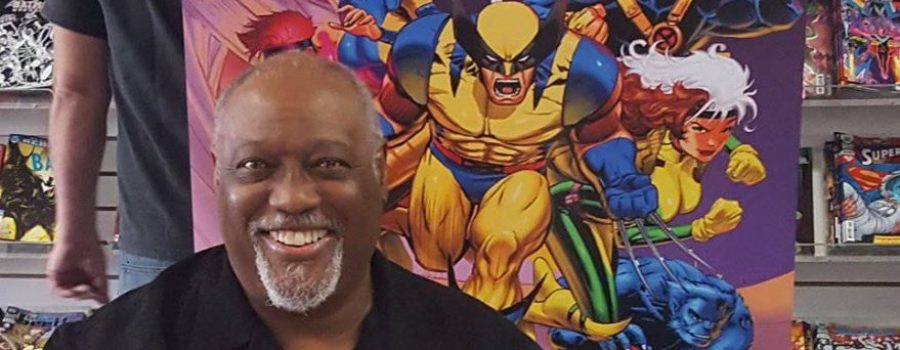Some people live for their culture and are so proud of it and that is 100% awesome but for a mixed-latchkey kid, mine has always been of the pop culture variety. From after school cartoons to MTV, the small screen raised my brother and me and in turn, we have to thank Larry F. Houston for part of that.
We lived for G.I. Joe, Teenage Mutant Ninja Turtles, and my personal favorite Captain Planet and the Planeteers. All of which Houston played a part in, especially the forever iconic X-Men: The Animated Series for which he was the first Black Saturday Morning Storyboard Artist.
It was an honor to share a piece of my existence with a man as accomplished as Houston as we talked about everything from the struggle of the Blerd to animated toy aisles to what’s coming up for the always working legend.
Kendra: It’s apparent when you attend conventions that fans aren’t only passionate about this and that because it’s cool, but because they often connect to it on a personal level. For you, what was the first personal connection you made to pop culture that made you not only a fan of what you do today but made you want to pursue it as a full-fledged career?
Larry F. Houston: I first became aware of comic book pop culture way back in elementary school in the ‘60s when I read some comic books at a local barbershop; Donald Duck, Batman, Superman, Fantastic Four, Casper, Hot Stuff, and Richie Rich. The top third of most of these books were removed but the rest was intact and readable.
It took me a while to discover what the indicia was and what the actual title of the books were. The artwork and the colors, as well as the challenging new vocabulary, fascinated me. Those books and the anime TV cartoon show Astro Boy led me to try and draw those characters at home and school.
As I grew older, I would create my own versions of the Marvel and DC superhero comic books I was reading, just for my own entertainment. It wasn’t until high school in the ‘70s that I ran into like-minded Black nerds like myself, who enjoyed drawing and writing fantasy escapism like I did. I also discovered a national network of similar fans that created and sold their creations in and through fanzine magazines like The Comic Reader, The Comics Journal, and the Comics Buyer’s Guide. We did all our communication by mail and letters and attending comic book shops and comic book conventions.
Kendra: Today being a Black nerd, or rather Blerd is easier than it was even when I was a kid in the ’90s. So what was it like for you growing up interested in comics and whatnot?
Larry F. Houston: Growing up as a Blerd in the ‘60s and ‘70s in South-Central Los Angeles was not at all embraced by my peers. Nor was speaking proper English. But I had a few I could relate to. And my Mom supported all my crazy interests in reading Popular Science magazines and buying me sketchbooks for my cartoon ideas, giving me a small allowance to buy various comic books to read at my local thrift stores, and ordering how-to-draw Famous Artists art books to learn from. Pretty much, I self-taught myself art and storytelling by immersing myself in my comic books and TV show interests. Quinn Martin shows like The Fugitive and The Invaders unconsciously taught me story structure, something you couldn’t find or learn about where I lived.

Kendra: Your name will always be synonymous with animation because of being the first Black storyboard artist of Saturday Morning Cartoons. So when you started to work on X-Men: The Animated Series, a comic that has always been looked at as this allegory for racism, did you feel like your career had come full circle a bit? Being able to bring these characters that have been classified as “the other” to people around the world as a leading Black storyboard artist?
Larry F. Houston: I hadn’t thought of it that way but, yeah, being the first black Saturday Morning Storyboard Artist who guided the X-Men mythos to TV is a bit full-circle. X-Men was always my favorite comic book at Marvel, with the Silver Age ‘60s DC Superman books a very close second. While working at Stan Lee’s Marvel Productions in Sherman Oaks, CA, I would scour the incoming scripts for Spiderman & His Amazing Friends for anything X-Men related and would request that I wanted to storyboard that section.
I did write one episode, “Swarm,” for Amazing Friends. I got paid for it but I didn’t get the credit. I kept the receipts though, as proof. I worked at Marvel for a decade, trying to get the networks interested in the X-Men. We did a half-hour pilot called “Pryde Of the X-Men”, co-directed and co-storyboarded by Will Meugniot, Rick Hoberg, and myself. None of the networks were interested in it, though. They didn’t get it.
Only shows like Scooby-Doo or Super-Friends were the successful template they wanted to see. Fast-forward six years and Margaret Loesch, my other boss at Marvel Productions, now the new CEO of the Fox Kids Network, called me, Will, Rick, and others, telling us she was green-lighting the series for Fox Kids. Woo-hoo! The best call ever!
Kendra: I’ve seen you talk at LA Comic Con about X-Men and I’m sure those questions will come your way years down the line, but I want to move on to TMNT because as someone who has a brother OBSESSED with it, a seven-year-old nephew who loves it, and has a husband whose only childhood memories he kept are several TMNT toys, I had to put a question about them in here. On the surface, the story of TMNT is out there but for some reason, it has been able to resonate much in part to the series’ you’ve worked on. Why do you think this crazy story about mutant turtles has continued to find fans with every new generation?
Larry F. Houston: One aspect I found attractive to me was that is was about four young “kids” having fun, eating pizza, partying, and fighting goofy villains using ninja skills. As a kid, you could project yourself as one of them and having fun with them. You wanted to be a part of that world where it was only “fun danger” you had to deal with. It was perfect escapism for a certain kid demographic, between eight and twelve-years-old. And the intro music! That catchy and cool music gave you the feeling something fun and exciting was about to begin and that expectation kept you glued to the set.
As a storyboard artist, the TMNT studio, Murakami-Wolf Studios, and their directors Bill Wolf, Tony Love, and Eliot Daro let me create and enhance and modify scenes without a lot of micro-management so that my sections of the show were as exciting as I could make them. I drew 118 episodes freelance at night while working at Marvel Productions in the day. That’s youth for you. I could not do that today.

Kendra: Really quick, do you think Captain Planet would be able to handle the current state of the world or would just look at Earth while a single tear ran down his cheek?
Larry F. Houston: I think a single tear would be it. Otherwise, in order to save the world, he’d have to become the villain of the world to do so. That might be a compelling story, actually.
Kendra: So it’s apparent you’ve helped shape the lives of so many millennials thanks to your work that spans back to the ’80s. Which, with Netflix’s Toys That Made Us, we’re learning how shows then and in the ’90s were sometimes just made to push toys, but nowadays toy stores and aisles are kind of like ghost towns. And it does seem like we have less animated series for kids then we used to. Do you feel the lack of interest in toys has put any sort of damper on studios wanting to make animated series since they can’t push as many products as they used to?
Larry F. Houston: Actually, almost all animated shows on streaming or cable still depend on the ancillary income from toys and other products to stay on the air. There is no way to recoup the millions of investment in creating a cartoon series from just the commercial ad revenue it generates. And since there is no longer a Saturday Morning that aggregated kid viewership and ratings (10-23%), niche cartoon channels have to deal with a fraction of the same ratings (0.5 – 3%) we had enjoyed.
So toys and ancillaries are still very much needed. New action-adventure shows like the X-Men are not being pursued by the studios as much, like before, though. Pixar-type comedy-adventure hybrids are what studios want since they can maximize their ancillary toy and apparel revenue with that certain family demographic.
Kendra: As someone who has worked on some of the most iconic series, when you look at the current landscape of animation, what series stand out as potential candidates to live on forever like X-Men and TMNT?
Larry F. Houston: WB’s Young Justice, which just got picked up and Static Shock, which definitely should get a pickup. I worked on Static, it had great ratings, the kids loved it, but WB could not get a toy deal, so they kept moving its time-slot around, hoping to “kill” it but the kids kept finding it, keeping its ratings high. But it was ultimately canceled.
Kendra: With that, can you let the people know what you have going on right now? Series you’re working on, conventions they can come fan out over you at?
Larry F. Houston: I am currently working on and developing my childhood superhero series The Enforcers and The Vanguards, adapting them for re-publication and pursuing TV development deals (fingers crossed). I’m updating my website, with any and all updates on these projects, but it is still a work-in-process so bear with me. I’m not the best tech guy. I’m also touring with the voice actors of The X-Men at different conventions, coast-to-coast, signing prints and having great conversations with the fans. As the dates become finalized, I will post them for all to see.







